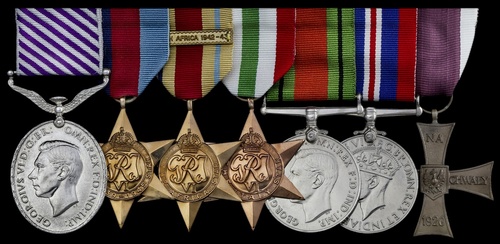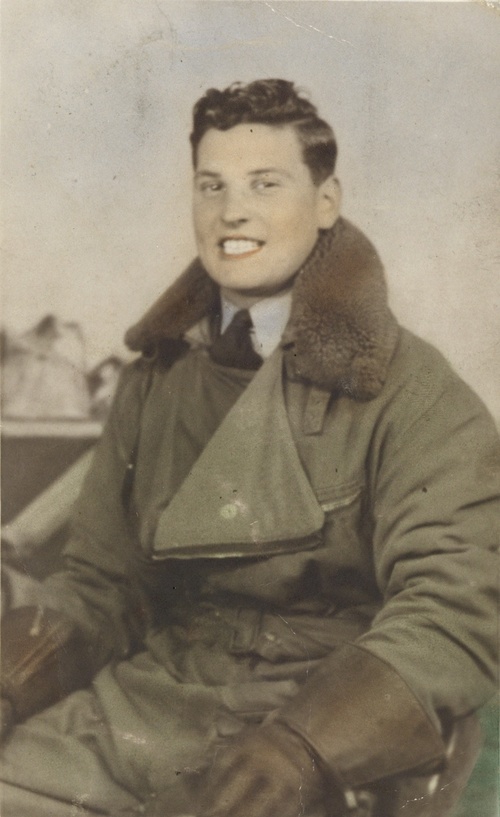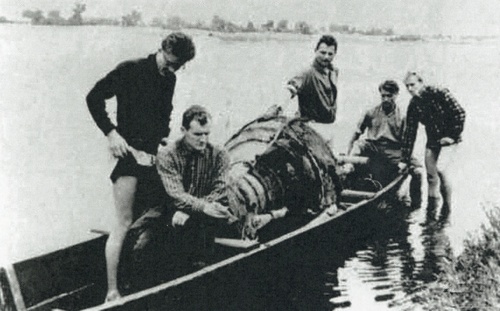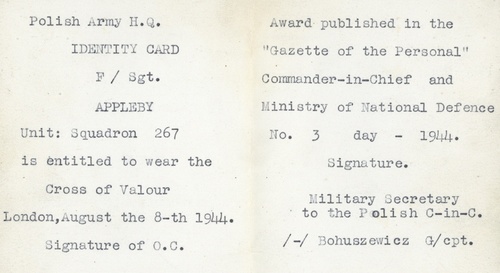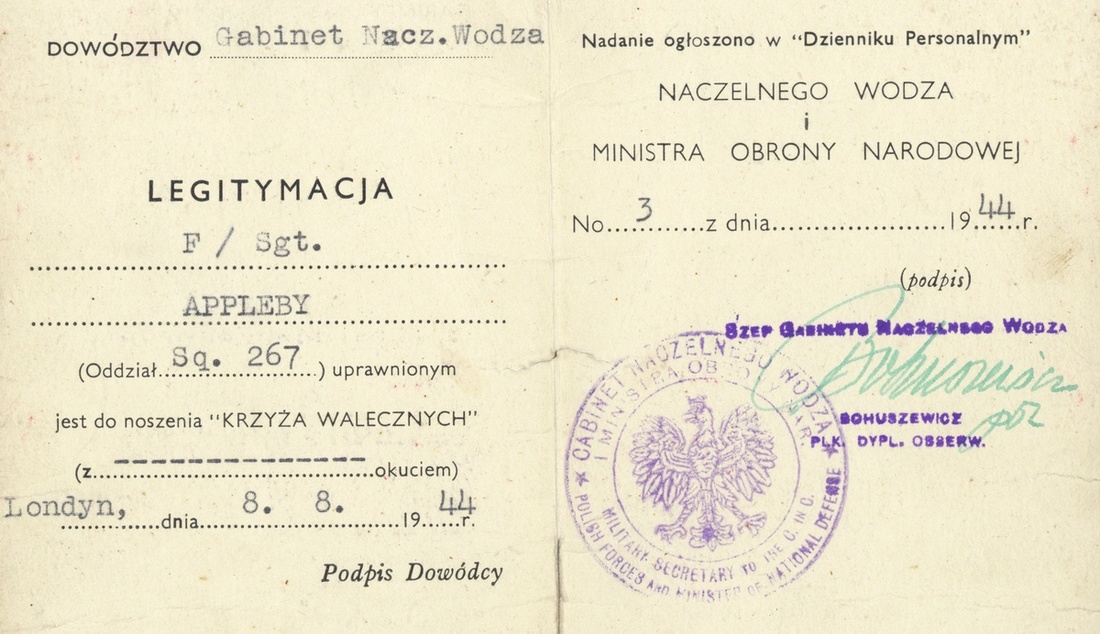Auction: 19002 - Orders, Decorations and Medals
Lot: 410
An important Second World War clandestine operations' D.F.M. and Polish Cross of Valour group of seven awarded to Warrant Officer J. Appleby, Royal Air Force Volunteer Reserve
A Wireless Operator employed on special duties in Dakotas of No. 267 Squadron, he was decorated for his part in Operation "Wildhorn III" in July 1944, an operation afterwards described as 'one of the most outstanding and epic flights of the War by an unarmed Transport aircraft'
And that wasn't all, for he and his crew returned from their perilous trip to Nazi-occupied Poland with the dismantled parts of a developmental V-2 rocket. Rarely has such a crucial cargo been snatched from the jaws of the enemy or indeed at such a crucial time - for Hitler's V-weapon assault on the U.K. was in its devastating ascendancy
The events of "Wildhorn III" were later described by Bernard Newman in They Saved London (1955), a book which was turned into a feature film; since then the story has also been featured in the B.B.C. TV series The Secret War (1977), in addition to the G.D.R. movie Frozen Flashes. It's a story imbued with high drama and consummate courage and a moving reminder of our debt to such dedicated aircrew and the gallant Polish resistance
Distinguished Flying Medal, G.VI.R. (1315512. F/Sgt. J. Appleby. R.A.F.); 1939-45 Star; Africa Star, clasp, North Africa 1942-43; Italy Star; Defence and War Medals 1939-45; Poland, Cross of Valour, by Spink & Son, bronze, extremely fine (7)
D.F.M. London Gazette 17 October 1944.
Polish Cross of Valour London Gazette 1 September 1944.
One of 189 Polish Crosses of Valour awarded to British personnel in the Second World War.
John Appleby was born at Cwmbran, Wales in 1922 and originally enlisted in the 4th Battalion, Monmouthshire Regiment in September 1939. Having been discovered underage, he was discharged by February 1940.
He next enlisted in the Royal Air Force Volunteer Reserve and trained as an Air Gunner /Wireless Operator at R.A.F. Pembrey. Duly qualifying in December 1942, he was posted to No. 267 Squadron in Egypt in May 1943.
It was about this time the unit's Dakotas were deployed to clandestine duties, dropping supplies to assorted resistance movements. Appleby flew his first such sortie - to Kos - on 2 October 1943 and another - codename 'Cyanide' - on 22 March 1944. Thereafter, in the period leading up to November, the pace of such activities quickly accelerated, a period that witnessed Appleby carrying out 34 missions of a clandestine nature.
Thus a spate of sorties supplying the partisans in Northern Italy, North-West Greece and Yugoslavia, relevant codenames and circuits including 'Icurist', 'Crayon', 'Piccadilly Mews', 'Cuckold' and 'Towan Bucket', to name a few. However, it would be for his subsequent role in "Windhorn II" - the above cited solo mission to Nazi-occupied Poland, that Appleby was awarded his D.F.M.
"Wildhorn III" - setting the scene
By the summer of 1944, flying bombs were landing in London - and elsewhere in Britain - at an alarming rate. The need to intercept, understand and counter the threat became a vital part of the war effort, for over and above the death and destruction caused, there was growing concern over a collapse in public morale.
As early as December 1942, Hitler had authorised the manufacture of the V-weapons, but due to design and testing issues, they did not enter an operational phase until late 1943. In so far as gathering proper intelligence on the V-2 programme, it would not be until May 1944 that an opportunity arose. On the 22nd of that month, during a test firing, a V-2 came down in a swamp near Sarnaki on the Bug River, a fact not lost on the Polish Underground Army (AK), who managed to recover it.
The AK hid the rocket under reeds until it could be safely removed to a barn nearby. It was then transported by cart, under potatoes, on little-used rural roads that were shadowed by armed partisans.
Jerzy Chmielewski and Antoni Kocjan then worked to dismantle - and log - all 25,000 components of the rocket with a team of engineers and scientists from Warsaw. The V-2 in question - an enhanced version - included a new type of guidance system that had not been seen before. Detailed reports with diagrams, photographs and a chemical analysis of the propellant were duly made for delivery to London.
Of particular interest was the unusual fuel composition - which was neither oil nor gasoline - and the AK attempted to transport a sample in a flask. The Polish couriers had no cars and had to transport the flask by bicycle on a relay basis. A resistant would bike for 10km and then pass the flask to a new rider, but it was soon discovered the flask became empty during the course of the journey. After two failed attempts, the riders were given a special flask with a precisely polished glass cap. This resulted in a successful run and it was discovered the solution was ethanol alcohol and water.
Meanwhile, no less than nineteen suitcases containing specialized equipment and V-2 parts, reports and photographs were readied to be smuggled to the boffins in London, together with Chmielewski and other scientists. Contact having then been made with the Air Ministry, the daring plans for Operation "Wildhorn III" were set in motion.
'A sitting duck'
On the night of 25-26 July 1944, Appleby was selected as Wireless Operator on Dakota KG477 'V', together with Flight Lieutenant C. G. Culliford (Captain), Flying Officer K. J. Szrajer (Second Pilot and Translator) and Flying Officer J. Pemberton-Williams (Navigator). Their aeroplane was stripped down of all armaments - they carried a small pistol between them - and fitted with four long-range cabin fuel tanks for the dangerous journey which lay ahead. Escorted by two Liberators during the daylight hours, the crew would have to fly on alone on the onset of dusk. As Flying Officer Szrajer put it:
'The Dakota was a sitting duck.'
Besides the importance of the completing the return leg of their journey, Appleby and his crew were charged with the outward delivery of four important Polish agents, namely Major Wolniak, Captain Billski and 2nd Lieutenant Starzynski, who were destined for the underground and carrying suitcases crammed with 'special equipment'. The fourth agent, Lieutenant Nowak, was to brief General Bor-Komorowski in relation to the estimates of military support in the event of an uprising.
The mission was set to be just the third landing undertaken by the R.A.F. in occupied Poland during the war. The landing strip, at Nowy Korczyn, some 200 miles south of Warsaw, was codenamed 'Motyl' (Butterfly) and was situated near a forest - it had earlier been used by the Luftwaffe. It was prepared by Polish Air Force Officer Wlodek, who was also to act as security on the night of Appleby's landing. Wlodek was a key player and since the bomb had been transported in a stolen German lorry, had acted as guard over the parts, keeping a keen eye on the local area - which bristled with some 4,000 German troops retreating from the Eastern Front and destined for defeat in Normandy.
The off
Having got 'wheels up' at 1730 hours from Bari, just one Liberator managed to get airborne, the other suffering engine issues. Parting company on crossing the River Sava, KG477 pressed on over the Hungarian plain at 7,500 feet, with all thankfully appearing quiet apart from five bursts of flak near Skolnok. Making their final turn at the Carpathian mountains just one minute behind E.T.A., the crew had displayed ' … excellent work given that there had been no pinpoints on this leg of the journey and the only navigational aid had been wireless bearings.' The very same bearings managed by Appleby.
Things were far from ideal at the L.Z. however, for 400 Luftwaffe personnel had made camp just a mile away and during the day three Storch aircraft had used the strip to make training landings and turns. Wlodek and his comrades stalked the ground, thanking high heaven that the aircraft moved off before dusk. Hundreds of underground resistance fighters - besides a good deal of local patriots - had gathered for the momentous operation but security was paramount.
A force of 25 AK officers brought oil lanterns from their homes and covered them with a cylinder made of stiff black paper. The lanterns could not be seen from the side, but their light was visible from the air.
It was a beautiful, pitch-dark night as the AK took up their positions on the airfield. Their commander, Colonel Baszak reported they were all shaking, and all had to remain completely silent. He said that he would have shot anyone who attempted to light a cigarette.
As Appleby and his crew drew near, they gave a light signal 'O' and received the correct signal 'N' in return. The mission was on.
At the signal of a whistle, everyone on the landing field removed the cardboard sleeves from their lanterns but the Dakota was a little too high and aborted its first landing attempt, Baszak later commented that it ' … wailed like the devil'. But he managed to put down on a second attempt.
Hair-raising delays
A quick exchange was made, with the cargo and agents exiting the plane and the precious prize being loaded, together with five passengers, Chmielewski, Retinger, Arcizewski of the Socialist Party, 2nd Lieutenant Chciuk and Micinski. All appeared to be running smooth but when Culliford attempted to get their Dakota airborne again, she was stuck fast in the boggy ground. For a moment it appeared the brakes had been applied in error, despite the controls stating their release. Given the proximity of the German unit, who may well have been stirred, time was now of the essence. The crew - undoubtedly aware of the grim fate that awaited them if they failed - cut the links to the brake fluid drums but it made no difference.
Further engine boosts also failed to shift the Dakota and it appeared the mission might have to be aborted. Culliford prepared to destroy the aircraft but was persuaded to stay a little longer. A spade was produced and some hard digging and a further engine boost made the Dakota slew slightly to starboard, with the port wheel having done one quarter of a rotation. At this point ' … the aircraft was again unloaded and Appleby tore up all his documents and placed them ready to set fire to the Dakota.'
With further pleading from Wlodek and an apparent delay in the approach of the German patrol, Culliford allowed for 30 minutes of hard digging. Finally - mercifully - the Dakota was released from the quagmire and it ran in a brake-less circle, just missing a stone wall on the edge of the strip. By this time all the torch-bearers had either dispersed or taken up positions secreted near the German camp, willing to fight and die for the success of the mission and the hope of liberation for Poland.
Culliford quickly deployed his landing light and, aiming at a green light in the far corner of the field, he somehow got the Dak up to 65 m.p.h., 'ploughing' through the ground before 'waffling' into the air. Pilot, crew, passengers and their vital cargo crossed the Yugoslavian frontier just before daylight.
Mission complete, Culliford was forced to make a brake-less landing at Brindisi on a runway still under construction, Having then flown to Bari at 0705 hours on 26 July aboard KG496, they were reunited with KG477 for the journey to Hendon, via Rabat Sale and Gibraltar, and arrived in Blighty in the early hours of 28 July.
Their remarkable feat won high praise, Wing Commander Francombe of No. 267 Squadron describing their sortie as 'one of the most outstanding and epic flights of the War by an unarmed Transport aircraft.'
Subsequent career
Appleby, who would fly further missions before being rested towards the end of November 1944, was duly awarded the D.F.M. He was a rare British recipient of the Polish Cross of Valour.
Having then attained the rank of Warrant Officer by the time his release in April 1946, Appleby was living Laurel Green, Upper Cwmbran when he claimed his campaign Medals in April 1979.
Sold with a quantity of original documentation, including the recipient's Observer's and Air Gunner's Flying Log Book (Form 1767 type), covering his entire wartime career, together with Buckingham Palace D.F.M. forwarding letter and R.A.F. Release Book, his A.G./W. Op uniform brevet and a portrait photograph.
Subject to 20% VAT on Buyer’s Premium. For more information please view Terms and Conditions for Buyers.
Sold for
£8,500
Starting price
£3800

